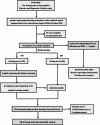Establishment of predictive models for postoperative delirium in elderly patients after knee/hip surgery based on total bilirubin concentration: machine learning algorithms
- PMID: 40739627
- PMCID: PMC12312243
- DOI: 10.1186/s12871-025-03259-9
Establishment of predictive models for postoperative delirium in elderly patients after knee/hip surgery based on total bilirubin concentration: machine learning algorithms
Abstract
Background: With the aging demographic on the rise, we're seeing a spike in the occurrence of postoperative delirium (POD). Our research aims to delve into the connection between plasma bilirubin levels and postoperative delirium, with the goal of crafting ten machine learning (ML) models capable of predicting POD instances.
Methods: This study enrolled 621 elderly patients after knee/hip surgery. We used the Confusion Assessment Method (CAM) to assess whether participants had POD. Univariate binary logistic regression analysis and restricted cubic spline (RCS) analysis were used to evaluate the association between plasma total bilirubin and POD. This study further investigated whether cerebrospinal fluid plays some role in the relationship between bilirubin and POD using mediated causal analysis. Subsequently, we employed ten machine learning algorithms to train and develop the predictive models: Logistic Regression (LR), Support Vector Machine (SVM), Gradient Boosting Model (GBM), Neural Network (NN), Random Forest (RF), Xgboost, K-Nearest Neighbors (KNN), AdaBoost, LightGBM, and CatBoost. The performance of the models was evaluated by the area under the receiver operating characteristic curve (AUROC), Brier score, accuracy, sensitivity, specificity, precision, F1 score, calibration curve, decision curve, clinical impact curve, and confusion matrix. In addition, the model was interpreted through Shapley additive interpretation (SHAP) analysis to clarify the importance of bilirubin in the model and its decision-making basis.
Results: Univariate binary logistic regression analysis revealed that plasma total bilirubin was associated with POD. Furthermore, the RCS analysis illustrated there was no nonlinear relationship between total bilirubin and POD. Mediation analysis indicted that T-tau mediated the effect of total bilirubin on POD. Total bilirubin and other features(age, educational level, BMI, history of diabetes, ASA, albumin, Aβ42, T-tau and P-tau) were used to construct ML models. Compared with other ML algorithms, NN showed better performance, with an AUC of 0.973 (95% CI (0.959-0.987)) in the test set. In addition, the SHAP method determines that age and education are the main determinants that affect the prediction of ML models.
Conclusion: Plasma total bilirubin was identified as a preoperative risk factor for postoperative delirium (POD). Among ten ML models, the Neural Network (NN) incorporating total bilirubin showed the best predictive performance for POD.
Trial registration: Clinical Registration No. ChiCTR2000033439. Registration data:2020.06.01.
Keywords: Cerebrospinal fluid; Machine learning; Postoperative delirium; Surgery.
© 2025. The Author(s).
Conflict of interest statement
Declarations. Ethics approval and consent to participate: The study was carried out according to the Helsinki Declaration of Helsinki Principles. Qingdao Municipal Hospital’s Ethics Committee approved this study (PNDABLE: ChiCTR2000033439, registration date: 01/06/2020). The patients/participants gave their written informed consent to participate in this study. Consent for publication: Not applicable. Competing interests: The authors declare no competing interests.
Figures







References
-
- Igwe EO, Nealon J, O’Shaughnessy P, Bowden A, Chang H (Rita), Ho M Incidence of postoperative delirium in older adults undergoing surgical procedures, et al. editors. A systematic literature review and meta-analysis. Worldviews Evid Based Nurs. 2023;20:220–37. - PubMed
-
- Thakkar M, Edelenbos J, Doré S. Bilirubin and ischemic stroke: rendering the current paradigm to better understand the protective effects of bilirubin. Mol Neurobiol. 2019;56:5483–96. - PubMed
MeSH terms
Substances
Grants and funding
LinkOut - more resources
Full Text Sources
Medical

